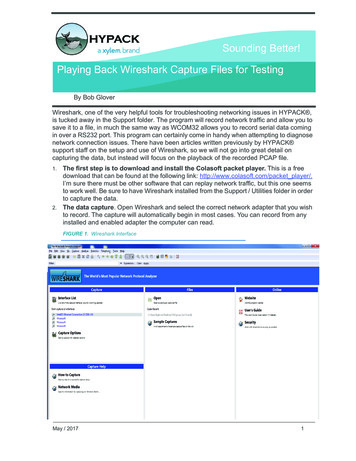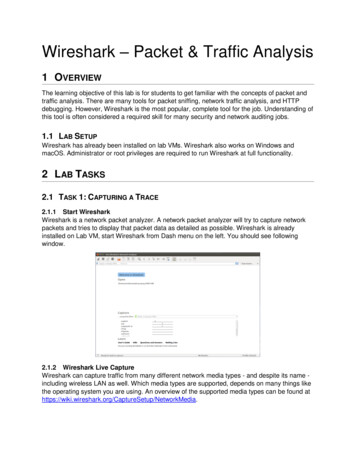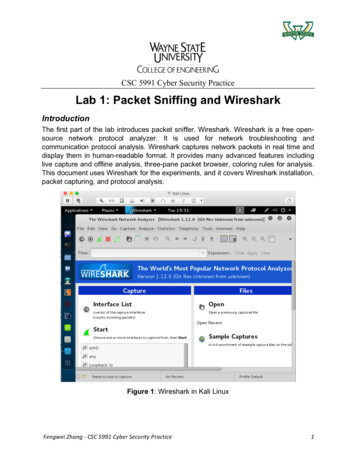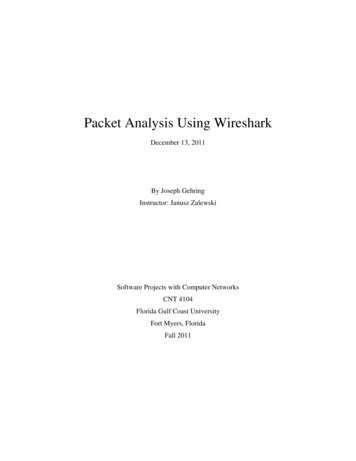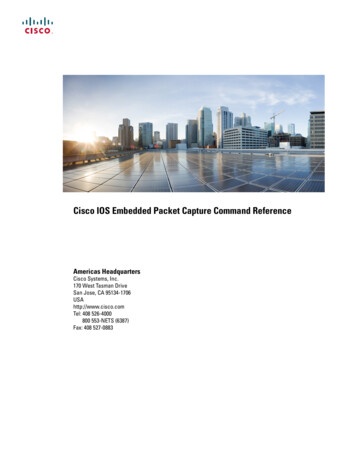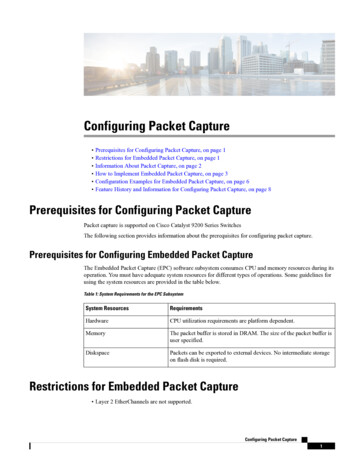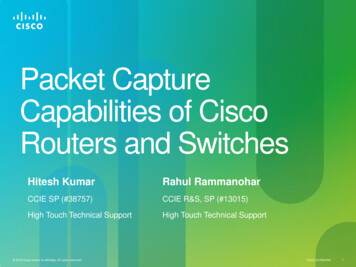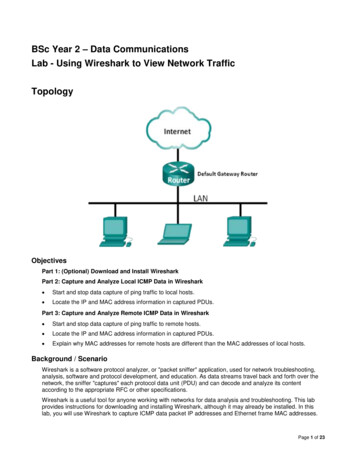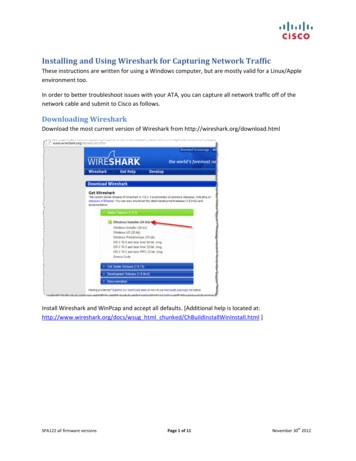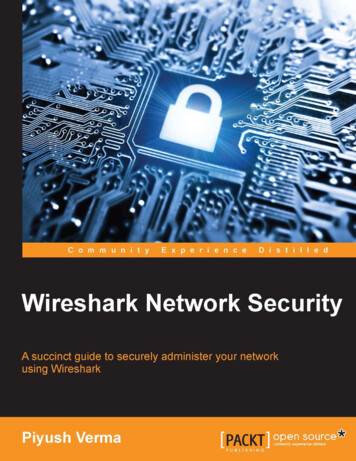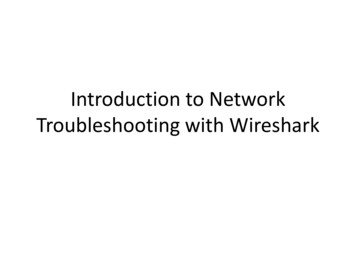
Transcription
Packet Capture TechniquesPaul Offord, Advance7
Groups of capture techniques Directly from the user PC or on a server Based on switch capabilities Via purpose-built devices In a virtual environment
On The Client: TopologyNetworkServerPC
Wireshark executablesStart WiresharkStart a capture
Very Large Frames
TCP Segmentation OffloadProcessPC orServerNICTCPIPDriverTCPL 5 KBWithoutLarge Receive Offload(LRO)L 1,518 bytesL 1,518 bytesIPEthEthernetSwitchPC or ServerL 1,518 bytesL 1,518 bytesL 1,518 bytesL 798 bytesL 1,518 bytesL 1,518 bytesMay be bigger thanJumbo Frame( 9,000 bytes MTU)
On The Client: Advantages Easy to achieve Zero disruption to services Capture wireless traffic Capture VPN traffic inside the tunnel
On The Client: Considerations TCP Seg. Offload can be confusing Disk contention may cause lost packets Potential performance hit when saving to C:- Page files, EXEs, DLL, Memory Mapped Files- Consider USB drive Use dumpcap for long-term captures
On The Server: TopologyNetworkServerUsedumpcapPC
Discovering unknown interactionsNetworkAnotherserverServerPC
On The Server: Advantages Relatively easy to achieve Minimal disruption to services- Change Request probably needed All client traffic visible All interactions with other services visible Blade and VM east-west traffic visible
On The Server: Considerations TCP Seg. Offload can be confusing Volume of data higher than client-side capture Save to a dedicated volume- Not to C: drive, database log vols, etc.- USB drives work well Use dumpcap not tshark or Wireshark Care needed when teaming used Intra-OS tracing not possible on Windows- Loopback adapter not the same as Linux
Via loopbackLinux OSAppServerDatabaseServerdumpcapSource and destination IP address is 127.0.0.1– use TCP port number to determine packet direction
RawCapWindows OSAppServerDatabaseServerRawCapProduces PCAP filesIPv4 onlyWindows 2008 r2 onwards
Time forQuestions
SPAN-Monitor-Mirror: TopologySource PortSwitchNetworkDestination PortCaptureServerCisco – monitor session Juniper - set ethernet-switching options analyzer PC
SPAN-Monitor-Mirror: UplinkNetworkCaptureNSwitchVoice VLANServer VLANPC to any serverSNo server to serverPhone to IPTNo IPT to IPTEWIPTSystemServers
SPAN-Monitor-Mirror: VLANNetworkCaptureSwitchVoice VLANServer VLANPC to any serverServer to serverNo IPTNo IPT to IPTIPTSystemServersPackets flowingNorth-Southwill appear in thecapture twice(flagged as Dup’s)
AsymmetricRouting GotchaWANSHSRP /VRRPPairPCoreSwitchCoreSwitchRouterUser VLANsSwitchWAN transit VLANServer VLANSvrSvrSvrSvr
Teaming (LBFO)NetworkSwitch ASwitch BTeamServerOptions:- Active/standby- Generic or static teaming (IEEE 802.3ad)- Dynamic teaming (IEEE 802.1ax, LACP)Always captureboth interfaces!
Teaming: Switch independent modeNetworkSwitch ASwitch BTeamServer
SPAN-Monitor-Mirror: Advantages Easy to configure Low risk – non-invasive Multiple sources into one destination Entire VLANs can be monitored- Need to monitor on each switch- May see duplicates Negligible impact on the switch
SPAN-Monitor-Mirror: VLAN GotchaSwitch AVLAN130CaptureSwitch BServerThis won’t work!PC
SPAN-Monitor-Mirror: 2-into-1Source PortDestination PortRx - 1GbpsMonitor - 2Gbps(switch Tx)Tx - 1Gbps
Cut-through switchesNexus SwitchEthernetIn theory, the switch justneeds to see the DMACaddress.IPTCPIn practice it uses more sothat it can support ACLs etc.
Virtual Output QueuesNexus SwitchIngress portVOQEgress port
Cisco Nexus Back-pressure GotchaNexus SwitchIngress portVOQmonitor sourceQueuing due tomonitor destinationport congestionmonitor destination
SPAN Rate LimitingConfiguring the Rate Limit for SPAN TrafficBy configuring a rate limit for SPAN traffic to 1Gbps across the entire monitor session, you can avoidimpacting the monitored production traffic. For Nexus 5000 series switches: When spanning more than 1Gbps to a 1 Gb SPAN destination interface, SPAN source traffic willnot drop. When spanning more than 6 Gbps (but less than 10Gbps) to a 10Gb SPAN destination interface,the SPAN traffic is limited to 1Gbps even though the destination/sniffer is capable of 10Gbps.On the Nexus 5500 series, SPAN traffic is rate-limited to 1Gbps by default so the switchport monitorrate-limit 1G interface command is not supported. Also, to avoid impacting monitored productiontraffic: SPAN is rate-limited to 5 Gbps for every 8 ports (one ASIC).Different rules andfor 5 Gbps.RX-SPAN is rate-limited to 0.71 Gbps per port when the RX-traffic on thecommandsport exceedsNexus 7000
SPAN-Monitor-Mirror: Considerations Overload of the monitor destination Back-pressure on source port (Cisco Nexus)- Alleviated using source rate limiting Limited number of monitor sessions Requires a spare switch port for destination Makes and models vary - review first
Cisco ACL / VACL: TopologyACL – Access Control ListVACL – VLAN Access Control ListMatch a packet to criteriaSwitchTake an actionCaptureServerPC
Cisco ACL / VACL: Advantages VACL Capture on Catalyst ACL Capture on Nexus Similar to monitor/mirror but also Wide range of monitor criteria- IP addresses, port numbers, etc.- Helps avoid destination overload More sessions possible Is this the future for capture on Cisco?
Cisco ACL / VACL: Considerations As per monitor/mirror plus Complicated to configure Greater risk of a mistake and so production impact Risk of not capturing the expected traffic
Time forQuestions
Blade Enclosure: Front
Blade Enclosure: Rear
Blade Enclosure: eServerCaptureEnclosure SwitchNetwork
Blade Enclosure Enclosure SwitchNetwork
Blade enclosure: Advantages Easy to configure Low risk – non-invasive Multiple sources into one destination Often entire VLANs can be monitored- Need to monitor on each switch- May see duplicates Negligible impact on the switch
Blade enclosure: Considerations Overload of the monitor destination Limited number of monitor sessions Requires a spare switch port for destination- Often all external ports are in use Makes and models vary - review first
Cisco UCS Fabric InterconnectStorageUCS Interconnect SwitchFCoEServerLimited to 1GbpsCapture
Cisco UCS Fabric InterconnectStorageUCS Interconnect SwitchEthernetServerLimited to 1GbpsCapture
UCS Fab Interconnect: Advantages Quick and easy to configure Visibility to East-West traffic Monitor multiple source Monitor VLANs Capture storage traffic (FCoE)
UCS Fab Interconnect: Considerations Monitoring limited to 1Gbps- This probably negates the storage trace capability Monitor src and dst must be on same FI Limit of two monitor sessions
Time forQuestions
TAPCaptureNon-aggregator TapAggregator TapSwitchSwitchTAPTAPServerCaptureServer
TAP: Advantages Reduces risk of dropped packets Captures all information including physicalerrors Totally passive Will not affect host performance
TAP: Considerations Need to break network link to install More expensive Less flexible Non-aggregators require two capture ports Aggregators suffer 2-into-1 problem
Network Packet NMonitorMirrorTAPOtherSources
Time forQuestions
ESX vSwitch Promiscuous ModeESX chNetworkPCWTS orvSphereClient
Promiscuous Mode: Advantages Minimal disruption to services- Change Request probably needed Can capture all intra-vSwitch traffic- East-West
Promiscuous Mode: Considerations vAnalyser VM required Care regarding destination of trace data- Not to sensitive volumes Anecdote that causes high CPU load- This has not been our experience Capture will not follow vMotioned guest
Hyper-V Monitor yser(dumpcap)RDPvSwitchNetwork
Hyper-V Monitor Port: Advantages Similar to monitor/mirror on a physical switch Minimal disruption to services- Change Request probably needed Can capture all intra-vSwitch traffic- East-West
Hyper-V Monitor Port: Considerations vAnalyser required Care regarding destination of trace data- Not to sensitive volumes
Ixia Phantom vTapESX / Hyper-V / tworkCaptureGRE Terminator
Ixia Phantom Tap: Advantages No software required on VM’s No impact to VM performance vTap can capture all vSwitch traffic Or can capture specific traffic Works on the leading hypervisors Can track a VM thru’ ESX vMotion
Ixia Phantom Tap: Considerations vTap Management VM on each host Annual subscription for each physical host Sensitive to vTap Mgmt. VM performance
Further informationPaul Offord FBCS CITPMobile: 44 1279 211 668Email: paul.offord@advance7.comWeb: www.advance7.comLinkedInCommunitiesTribeLab- Free tutorials- Free guides- Free resources
Cisco ACL / VACL: Advantages VACL Capture on Catalyst ACL Capture on Nexus Similar to monitor/mirror but also Wide range of monitor criteria - IP addresses, port numbers, etc. - Helps avoid destination overload More ses
